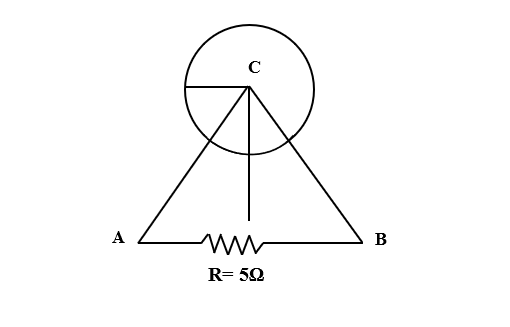
A uniform magnetic field of intensity $B={B}_{0} \sin (\omega t)$ directed into the plane of the paper exists in the cylindrical region of radius r. A loop of resistance $R= 5 \Omega$ is folded in the form of an equilateral triangle of side length 2r is placed as shown in the figure. The maximum potential drop in the wire AB is

A. $\dfrac {\pi {r}^{2}{B}_{0}\omega}{6}volt$
B. $\dfrac {\pi {r}^{2}{B}_{0}\omega}{3}volt$
C. $\dfrac {\pi {r}^{2}{B}_{0}\omega}{2}volt$
D. $\pi {r}^{2}{B}_{0}\omega$

Answer
546k+ views
Hint: To solve this problem, use the relationship between magnetic flux, magnetic field and area. Find the area of the cylindrical region. Substitute the area and magnetic field in the formula for magnetic flux. Then, integrate the obtained equation. For potential drop to be maximum, use the condition $\cos {\omega t}= 1$. Substitute this condition and find the maximum potential drop in the wire AB.
Formula used:
$\phi= BA$
Complete answer:
Given: R= $5 \Omega$
Length of side of triangle (l)= 2r
The given triangle is an equilateral triangle. Hence, each angle is 60°.
$\Rightarrow \angle ABC= \angle BCA= \angle CAB= 60°$
Magnetic flux is given by,
$\phi= BA$ …(1)
Where, B is the magnetic field
A is the area perpendicular to the magnetic field B
Area of the cylindrical region is given by,
$A= \pi {r}^{2} \times \dfrac {60°}{360°}$
$\Rightarrow A= \dfrac {\pi {r}^{2}}{6}$ …(2)
Magnetic field is given by,
$B={B}_{0} \sin (\omega t)$
Substituting equation. (2) in equation. (1) we get,
$\phi= {B}_{0} \sin (\omega t) \times \dfrac {\pi {r}^{2}}{6}$ …(3)
Integrating equation. (3) with respect to time we get,
$\dfrac {d\phi}{dt}= {B}_{0}\omega \cos (\omega t) \times \dfrac {\pi {r}^{2}}{6}$ …(4)
The potential drop will be maximum at $\omega t=0°$.
Substituting this in the equation. (4) we get,
$\dfrac {d\phi}{dt}= {B}_{0}\omega \cos {0°} \times \dfrac {\pi {r}^{2}}{6}$
$\Rightarrow \dfrac {d\phi}{dt}= {B}_{0}\dfrac {\pi {r}^{2}}{6}$
Hence, the maximum potential drop in the wire AB is $\dfrac {\pi {r}^{2}{B}_{0}\omega}{6}volt$.
So, the correct answer is option A i.e. $\dfrac {\pi {r}^{2}{B}_{0}\omega}{6}volt$.
Note:
Students must remember the condition for maximum potential drop and minimum potential drop. For maximum potential drop we consider $\omega t=0°$. While for minimum potential drop, we consider $\omega t=90°$. But students should keep in mind that at $\omega t=90°$, we get the lowest absolute value. As the magnetic flux can also have a negative value.
Formula used:
$\phi= BA$
Complete answer:
Given: R= $5 \Omega$
Length of side of triangle (l)= 2r
The given triangle is an equilateral triangle. Hence, each angle is 60°.
$\Rightarrow \angle ABC= \angle BCA= \angle CAB= 60°$
Magnetic flux is given by,
$\phi= BA$ …(1)
Where, B is the magnetic field
A is the area perpendicular to the magnetic field B
Area of the cylindrical region is given by,
$A= \pi {r}^{2} \times \dfrac {60°}{360°}$
$\Rightarrow A= \dfrac {\pi {r}^{2}}{6}$ …(2)
Magnetic field is given by,
$B={B}_{0} \sin (\omega t)$
Substituting equation. (2) in equation. (1) we get,
$\phi= {B}_{0} \sin (\omega t) \times \dfrac {\pi {r}^{2}}{6}$ …(3)
Integrating equation. (3) with respect to time we get,
$\dfrac {d\phi}{dt}= {B}_{0}\omega \cos (\omega t) \times \dfrac {\pi {r}^{2}}{6}$ …(4)
The potential drop will be maximum at $\omega t=0°$.
Substituting this in the equation. (4) we get,
$\dfrac {d\phi}{dt}= {B}_{0}\omega \cos {0°} \times \dfrac {\pi {r}^{2}}{6}$
$\Rightarrow \dfrac {d\phi}{dt}= {B}_{0}\dfrac {\pi {r}^{2}}{6}$
Hence, the maximum potential drop in the wire AB is $\dfrac {\pi {r}^{2}{B}_{0}\omega}{6}volt$.
So, the correct answer is option A i.e. $\dfrac {\pi {r}^{2}{B}_{0}\omega}{6}volt$.
Note:
Students must remember the condition for maximum potential drop and minimum potential drop. For maximum potential drop we consider $\omega t=0°$. While for minimum potential drop, we consider $\omega t=90°$. But students should keep in mind that at $\omega t=90°$, we get the lowest absolute value. As the magnetic flux can also have a negative value.
Recently Updated Pages
The number of solutions in x in 02pi for which sqrt class 12 maths CBSE

Write any two methods of preparation of phenol Give class 12 chemistry CBSE

Differentiate between action potential and resting class 12 biology CBSE

Two plane mirrors arranged at right angles to each class 12 physics CBSE

Which of the following molecules is are chiral A I class 12 chemistry CBSE

Name different types of neurons and give one function class 12 biology CBSE

Trending doubts
One Metric ton is equal to kg A 10000 B 1000 C 100 class 11 physics CBSE

What is 1s 2s 2p 3s 3p class 11 chemistry CBSE

Discuss the various forms of bacteria class 11 biology CBSE

State the laws of reflection of light

Explain zero factorial class 11 maths CBSE

An example of chemosynthetic bacteria is A E coli B class 11 biology CBSE




